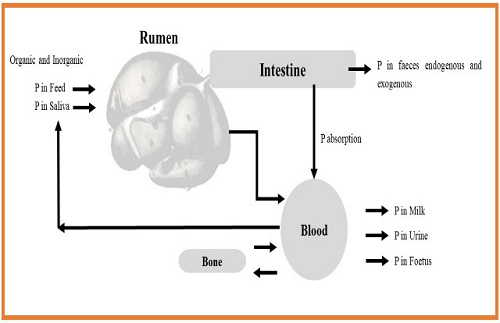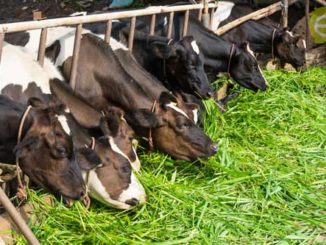Introduction
In Animal Nutrition, Phosphorus is one of the most important major mineral. It is the second most abundant element in an animal body after calcium, the major portion of Phosphorus i.e 80-85% is distributed in bone and teeth along with Ca and remaining Phosphorus 15 to 20% distributed in body fluid and soft tissue. Phosphorus (P) was discovered by Hennig Brand in 1669 through urine distillation and its Greek meaning is “bringer of light or light bearer”. P occurs abundantly in nature (0.08- 0.12 % weight in earth crust) both as in compound and elemental form.The compound forms of P are available as Organic compounds and Inorganic salts. The inorganic P occurs as phosphate while organic P occurs in plants as phytic acid, phospholipid, nucleic acid etc. Phosphorus (P) is an essential element for animals as it takes part in structural functions and in vital role in metabolism of ruminant animals.
Phosphorus Metabolism in Ruminants
In ruminants, Metabolism of P is complex processes. Reason for this complexity is that, a significant amount of P is incorporated by the rumen microbial population as a component of their nucleic acids and phospholipids. Furthermore, ruminants secrete a large amount of saliva containing inorganic P into the rumen, more than 100 litres per day. Therefore, ruminants require phosphorus both for growth of tissue and bone as well as for multiplication of microorganisms within the rumen.
Ruminants are unique because of this ability to recycle phosphorus to the early part of the gastrointestinal tract through both saliva and blood. Since the pH in the rumen is within the buffering range of phosphates, they serve as buffering agents for volatile fatty acids produced in the rumen, although the phosphate contribution to ruminal buffering relative to carbonates appears very low (Counotte et. al., 1979).
Phosphorus in Saliva
In ruminants, the salivary glands are the major site for endogenous inorganic phosphorus (Pi) secretion into the gastrointestinal tract (GIT). The P concentration in cattle saliva is 370-720 mg/litre (Clark et al., 1953).
Salivary Pi has 2 major functions:
- Acts as a buffer in the rumen,
- Provides adequate P for rumen microbes (Cohen, 1980).
Salivary secretions of P constitute about 80% of the endogenous P recycled to the gastrointestinal tract (the balance is mainly from bile), depending on dry matter intake (DMI), usually combined with P intake and the fibre content of the diet (Care, 1994). The daily secretion rate between 5 and 10 g Pi in sheep and between 30 and 60 g Pi in cows. It is achieved by both the high salivary flow-rate and the ability of the salivary glands to concentrate Pi 3-8 folds in comparison with plasma Pi. Therefore, the salivary glands have an important role in homeostasis of P.

Phosphorus Availability
The availability of P may be defined as the proportion of the dietary P which may be absorbed by the animal when it is absorbing P at a maximal rate. Phosphorus availability is based on the chemical form of P in the feed and various animal factors such as age, stage of production, and overall level of nutrition. For ruminants, the NRC (1996) estimates P availability to be 68%. Most livestock diets are derived from plant-based feedstuffs. These types of feeds contain the organic form of P known as phytate (Tillman and Brethour, 1958).
Main two Factors are Important for Ruminant Animals
- Ruminal phytase liberates one type of bound phosphorus-phytin phosphorus. This complex appears in many plants and the bound phosphorus has very low availability for non-ruminants.
- Pancreatic ribonuclease, which is secreted into the small intestine of ruminant animals in large amounts, releases the phosphorus present in nucleic acids reaching the small intestine for absorption and recycling to the rumen. In this manner, phosphorus used by ruminal microbes is well recovered. Phosphorus availability for the animal could theoretically differ from availability in the rumen. The term, ruminal phosphorus availability reflects the concentration of phosphorus in the rumen derived from solubilized or degraded feed ingredients as well as from recycling to the rumen of endogenous phosphorus through saliva and by diffusion through the ruminal wall.
Role of Phosphorus in Rumen
- Rumen microbes have a P requirement apart from the animal’s requirement which must be met for optimum rumen microbial activities to occur (Powell et al., 2002).
- Rumen microbes obtain P from the P released during fermentation of feed in the rumen and from salivary secretions.
- If a feed is low in its P content, then salivary P secretion also get lowered which ultimately affect the performance of microorganism in the rumen. However, maximum microbial derivative and synthetic activities can be maintained if ruminal inorganic P levels are at least 75-100 mg/L (Komisarczuk et al., 1987). The levels of P found in the rumino-reticulum are generally adequate for optimal microbial activity even with highly P-deficient diets.
Phosphorus Level in Blood
- The content of inorganic phosphorus in the blood is 4-9mg/100ml. Depending upon species and age. Whole blood contains 35-40 mg P/100ml. The maintenance of inorganic phosphorus level in the blood is governed by the same factors which promotes Ca and P assimilations. The element occurs in variety of forms (inorganic and organic P), mostly organic form is found. The inorganic form of P ranges from 4 to 8 mg/dl (about 10% is bound to serum protein and 50-60 % in ionized form) for dairy cattle with slightly higher value for young animals.
Phosphorus Absorption
Inorganic P sources which are water soluble are available for absorption in ruminant, while the solubility of P in organic compound depends upon the ability of the animal to convert organic into inorganic form or more acceptable organic form (Underwood and Suttle, 1999). In rumen, microbes secrete phytase enzymes which hydrolyzed the phytate P and released inorganic P. The organic P which is not hydrolyzed in rumen becomes soluble in low pH of abomasum. It is primarily absorbed in the small intestine mainly in duodenum and jejunum.
Phosphorus Excretion
In adult ruminant, Primary path for excretion of P is through faeces (Betteridge et al., 1986). Recently, Alvarez-Fuentes et al., (2016) reported that on average, lactating dairy cows excreted 58% of ingested P in faeces and 0.44% in urine, and secreted 40% in milk. Whereas, at constant P intake, cows with higher milk production excreted less P than cows with lower milk production.
Conclusion
The levels of Phosphorus found in the rumino-reticulum of ruminant animals are generally adequate for optimal microbial activity even with highly P-deficient diets.
References
- Betteridge, K. and Andrewes, W. 1986. Intake and excretion of nitrogen, potassium and phosphorus by grazing steers. J. Agric. Sci. (Camb.) 106, 393-404.
- Care, A. D. 1994. The absorption of phosphate from the digestive tract of ruminant animals. Br. vet. J. 150:197-205.
- Clark, R. 1953. A study of the water-soluble phosphate concentration of the ruminal contents in normal and phosphorus de®cient animals. Onderstepoort J. Vet. Res. 26: 137-140.
- Komisarczuk, S., Durand, M., Beaumatinp, H. and Hannequart, G. 1987. Effects of phosphorus deficiency on rumen micro bial activity associated with the solid and liquid phase of a fermentor (Rusitec). Reprod. Nutr. Dev. 27: 907-919.
- McDowell, R.W. and Sharpley, A.N. 2003. Phosphorus solubility and release kinetics as a function of soil test P concentration. Geoderma. 112 (1): 143–154.
- Powell, J. M., Jackson-Smith, D. B. and Satter, L. D. 2002. Phosphorus feeding and manure nutrient recycling on Wisconsin dairy farms. Nutr. Cycl. Agroecosyst. 62, 277–286.
- Underwood, E. J. and Suttle, N. F. 1999. The mineral nutrition of livestock, 3rd Edition, CABI Publishing, Wallingford, Oxon, UK.






1 Trackback / Pingback